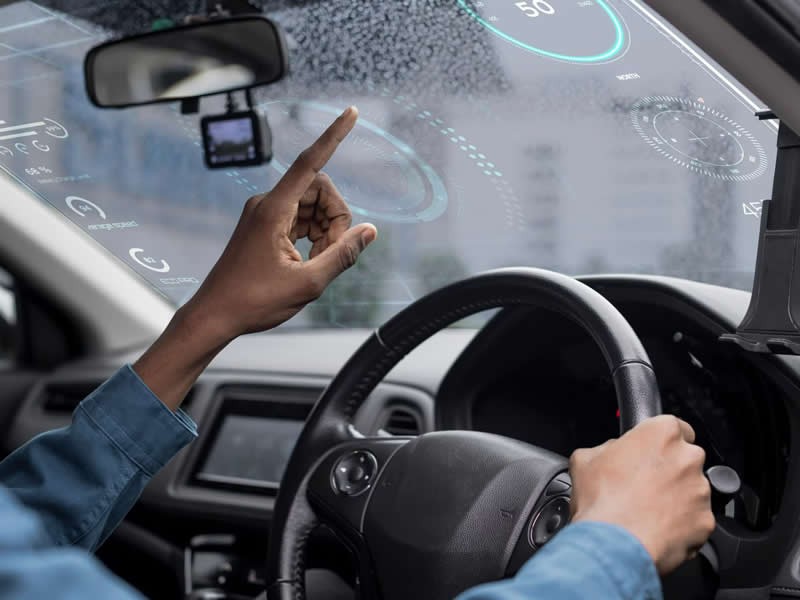Insight Blog
Agility’s perspectives on transforming the employee's experience throughout remote transformation using connected enterprise tools.
10 minutes reading time
(1947 words)
Understanding the Role of Telematics in Business Auto Insurance
Looking to gain insights into the role of telematics? Here, we delve deep into understanding how this innovative technology is transforming the industry.
In the world of business auto insurance, telematics has emerged as a crucial tool for insurers and companies alike. Telematics, which involves the use of devices to collect and transmit data on driving behavior, has revolutionized the way insurance is assessed and priced.
This innovation allows insurers to have a more accurate understanding of the risks associated with each customer, based on their driving habits and history.
Gone are the days when insurance rates were solely determined by factors such as age, gender, and location. Telematics enables a more personalized approach, where each customer's premium is influenced by their specific driving patterns.
By monitoring factors such as speed, acceleration, and braking, insurers can better assess the likelihood of accidents and assign appropriate premiums.
This technology also provides a valuable opportunity for customers to prove their safe driving, potentially resulting in significant savings.
For those with a clean driving record and a commitment to responsible driving, telematics can lead to lower insurance costs than the traditional "cheapest car insurance" company.
The Evolution of Auto Insurance in the Digital Age
In this fast-paced, technology-driven world, the auto insurance industry has also undergone a remarkable transformation. The digital age has revolutionized the way insurance companies operate and interact with customers.
With the advent of advanced telematics technology, the process of purchasing and managing auto insurance policies has never been easier.
One significant change in the evolution of auto insurance in the digital age is the ability to compare and purchase policies online. Customers no longer have to visit countless insurance agents or spend hours on the phone to obtain quotes.
With just a few clicks, individuals can compare different coverage options, insurance discounts, and premium rates from multiple cheap car insurance companies.
In fact, many insurance providers now offer discounts specifically for purchasing policies online, making it an even more affordable option for customers.
This accessibility and convenience have allowed consumers to make informed decisions about their auto insurance policy without the hassle of meeting with insurance agents in person.
How Telematics Devices Collect and Transmit Data?
Telematics devices have revolutionized the way data is collected and transmitted for business auto insurance. These devices are typically installed in vehicles and use a combination of GPS, accelerometers, and sensors to gather information about driving habits, vehicle performance, and location.
This data is then transmitted through wireless networks to insurance providers for analysis.
One of the key advantages of telematics devices is their ability to provide more accurate and personalized pricing for insurance policies.
Traditional methods of determining rates, such as using an individual's driving record or ZIP code, may not always reflect their actual risk profile.
With telematics, insurance companies can factor in real-time data, such as actual mileage, speed, and braking patterns, to assess risk more accurately. This means that drivers with safe habits can qualify for cheaper car insurance quotes, while those with riskier driving behaviors may face higher premiums.
Furthermore, telematics devices allow insurance providers to offer cheap auto insurance options tailored to individual needs. By analyzing data on factors like age, gender, and driving experience, insurers can identify different risk profiles within demographic groups.
For example, senior drivers who have maintained a good driving record may be offered lower rates compared to others in their age group.
With telematics, insurance companies can ensure that their customers are paying an average rate that reflects their actual risk profile, while also providing opportunities for customers to find the cheapest rates from the cheapest companies that suit their specific circumstances.
The Insurance Navy is one such popular service providing company that avails these cheapest insurance policies with a detailed information on the importance of telematics. Please visit their official site for a proper analysis.
The Benefits of Telematics for Business Auto Insurance
Telematics has revolutionized the way businesses approach auto insurance, offering a range of benefits that can help improve operational efficiency and decrease costs. One significant advantage is the potential for lower premiums based on a driver's credit score and driving habits.
According to a study by Quadrant Information Services, businesses with drivers who have higher credit score may enjoy cheaper car insurance rates compared to those with lower credit scores.
Telematics devices can track driving habits, such as speed, braking, and acceleration patterns, which can further influence insurance quotes. By incentivizing safe driving, businesses can not only promote better driver behavior but also secure more favorable rates for drivers on their fleet.
Moreover, telematics plays a crucial role in enhancing claims management. With real-time data transmitted by telematics devices, insurance companies can streamline the claims process, thereby reducing the time and effort required for claims handling.
This enables businesses to quickly address incidents and get their vehicles and drivers back on the road as soon as possible.
By accurately documenting accidents and providing objective evidence, telematics helps ensure a fair and smooth claims process for both business owners and insurance providers.
Follow us and access great exclusive content everyday: Follow us on Google News
Reducing Risk and Improving Safety with Telematics
To reduce risk and improve safety for business auto insurance, telematics play a crucial role.
By installing telematics devices in vehicles, auto insurance companies can monitor driving behavior and collect insightful data. This allows insurers to assess risk more accurately and customize insurance products based on individual factors such as driving habits and credit-based insurance scores.
One of the main benefits of using telematics is the potential for lower insurance costs. Insurance companies can offer more personalized pricing based on the data collected through the devices.
By analyzing driver behavior, such as speed, harsh braking, and acceleration patterns, insurers can identify high-risk drivers and adjust their monthly rates accordingly.
Some studies have found a positive correlation between credit history and driving behavior, which suggests a link between responsible financial behavior and safer driving.
As a result, individuals with better credit histories might be eligible for cheaper car insurance or more affordable auto insurance options.
This enhanced customization and flexibility enable drivers to find insurance policies that not only provide financial protection but also align with their budget and needs.
Enhancing Claims Management through Telematics Data
Enhancing claims management through telematics data is an integral part of the digital transformation that has revolutionized the auto insurance industry. B
y harnessing the power of telematics, insurance companies can streamline the claims process and provide a more efficient and personalized experience for their customers.
One of the key benefits of using telematics data in claims management is the ability to accurately assess the level of risk associated with each claim.
By analyzing data collected from telematics devices, insurance companies can determine the types of drivers involved in the accident, their driving behavior, and the specific circumstances leading to the claim.
This information can then be used to create a comprehensive profile of the claimant and provide a more accurate assessment of their risk profile.
The Telematics data can help insurance companies identify and mitigate fraud. By analyzing the data collected from telematics devices, insurers can detect any discrepancies between the reported accident and the actual events.
For example, if a driver claims to have suffered a severe injury in an accident, but the telematics data shows that they did not activate the car's safety features, such as seatbelts or airbags, it raises a red flag for potential fraudulent claims.
This not only helps insurance companies protect themselves from false claims but also ensures that genuine claimants receive the compensation they deserve.
Using Telematics to Monitor Driver Behavior and Performance
Telematics devices have revolutionized the way driver behavior and performance are monitored in the insurance industry. This innovation is particularly crucial for teen drivers who are often considered high-risk due to their lack of experience on the road.
With telematics, insurance companies can collect data on various aspects of a teen driver's behavior, such as speed, acceleration, and hard braking. By analyzing this data, insurers can assess the level of risk associated with each individual driver and adjust their premiums accordingly.
Furthermore, telematics provides an opportunity for drivers to qualify for policy discounts based on their driving habits. This usage-based insurance approach enables responsible drivers to benefit from lower rates, as data collected by telematics devices can confirm their safe driving practices.
On the other hand, drivers with a history of poor driving behaviors, such as frequent speeding or sudden lane changes, may be subject to higher premiums. Overall, telematics allows insurance companies to personalize their offerings and incentivize safe driving, leading to a more accurate assessment of risk and fairer pricing for auto policies.
Telematics devices also take into account other factors that influence insurance rates. For example, they can consider the driver's credit score when determining the premium. Typically, drivers with poor credit scores are perceived as higher risk, leading to higher premiums. However, safe driving habits recorded by telematics devices can help mitigate this effect by demonstrating responsible behavior on the road.
Consequently, telematics allows insurers to create more comprehensive and tailored insurance policies that consider multiple variables, resulting in a more accurate assessment of risk and potentially reducing the average cost of coverage for drivers with a clean record.
You may also like: Best Apps for Employees: UPDATED 2022 – A Complete Guide
The Role of Telematics in Premium Calculation and Pricing
Telematics has significantly transformed the way insurance premiums are calculated and priced, allowing for more accurate and personalized rates.
By collecting data on various factors such as driving behavior, mileage, and location, insurers can better assess the level of risk associated with an individual policyholder.
This not only ensures that affordable car insurance is available to a wider range of people, but also helps insurers offer more competitive and tailored insurance products.
In the past, insurance premiums were primarily based on demographic information such as age, gender, and location.
This one-size-fits-all approach often marginalized certain groups of individuals, making it challenging to find affordable insurance that adequately met their needs.
However, with the advent of telematics, cheap car insurance quotes are now accessible to a broader audience. By considering individual driving habits and behavior, insurers can offer more affordable insurance policies that accurately reflect the risk profile of each policyholder.
This has led to a proliferation of affordable auto insurance rates and cheap insurance options, enabling individuals to find the right coverage at a price that suits their budget.
Additionally, telematics has also made gap insurance, which covers the difference between the actual cash value of a vehicle and the outstanding loan balance on it, more accessible to those who need it.
Wrapping up
In conclusion, understanding the role of telematics in business auto insurance is pivotal in the modern landscape of commercial vehicle management. Telematics technology empowers businesses with invaluable insights into driver behavior, vehicle performance, and overall fleet efficiency. In situations involving incidents such as hit-and-runs, consulting a hit and run accident lawyer specialise in providing the necessary legal support to navigate complex claims and ensure fair representation.
It enhances safety, reduces risks, and ultimately contributes to cost savings.
By embracing telematics, businesses can better tailor their insurance coverage to match real-world data, potentially reducing premiums and improving their overall risk profile.
Moreover, telematics supports proactive fleet management strategies, leading to enhanced productivity, reduced downtime, and increased customer satisfaction.
Free ebook: How To Get Your Intranet Off The Ground
Categories
Blog
(2569)
Business Management
(314)
Employee Engagement
(204)
Digital Transformation
(171)
Intranets
(119)
Growth
(114)
Remote Work
(61)
Sales
(48)
Collaboration
(37)
Culture
(29)
Project management
(29)
Customer Experience
(25)
Knowledge Management
(21)
Leadership
(20)
Comparisons
(5)
Ready to learn more? 👍
One platform to optimize, manage and track all of your teams. Your new digital workplace is a click away. 🚀
Free for 14 days, no credit card required.














